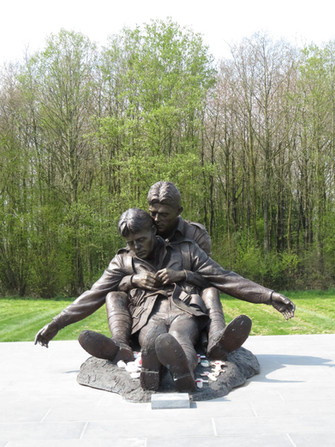Passendale to Ypres - A Day in Flanders Fields
(Observations and notes from the wisdom of the tour guide - and others - during a respectful small-group experience)

Langemark German Cemetery
In the World War I histories of “Gallant Little Belgium” (as taught to Australian kiddies in the 60’s, 70’s; 80’s) no-one really explores what happened to the Belgian Army after their king denied Germany free entry in 1914 to a section of his country in order to access northern France. The German military apparently thought that they could walk through Belgium in less than a week, but were shocked to discover that an army and a government defend surprisingly well when seeking to prevent an unprovoked invasion.
My, how “the thing that we learn from History is that we do not learn from history”…
The Belgians were unsure the English would honour their treaty obligations, and were grateful that they did; effectively bogging down the German advance in Flanders for years. The Belgians maintained the control of south west Flanders and the port of Niewpoort. The king and queen lived among them and worked with their people to maintain the war effort. The hospital where the queen worked as a nurse still exists (and is named after her) today.
And so begins a Flanders Fields small group tour out of Bruges for the day with a very dispassionate but knowledgeable local.
The tour of the former trenches is determined by the interests and nationalities of the paying punters: in our case Kiwis, Australians, Canadians, Brits and token American, all well beyond the first fresh bloom of youth.
What follows is the Wisdom of the Tour Guide on the day. It was 9 thoroughly informative but sombre hours and by an early lunch break we were pretty subdued as we were led slowly across the ridge from Passendale to Ypres, step-by-step, decision by decision; monument by monument in perhaps the most respectful excursion I’ve experienced. The verdant green of the farmland, the rebuilt houses and towns (church first, houses later when the centre of each community had been re-established, all at German war-reparation expense) and replanted forests only increase today’s visual and verbal impact of the fear and mess of war. This is particularly so when standing on the remains of Hill 62 which had been thoroughly tunnelled and mined for months before a single underground explosion killed hundreds of Germans.
Chlorine was used as a chemical weapon in the initial gas attacks (initially by the Germans; quickly copied by the allies with horrible - many unintended - results on both sides, however chlorine was too quick and effective (so not strategically disruptive enough to the enemy…). Scientists on both sides were sent to research something more lingering, resulting in the use of Phosgene which took months to kill victims through internal and external blistering and drowning in bodily fluids. It lacked a strong smell, so there was no signal rush to apply dodgy gas masks until it was too late. Even more effective in disruption, as victims slowly drowned in their own lung secretions, was that it soaked into and through uniforms. Nurses and doctors quickly cut the uniforms off gas victims to commence treatment, wIthout initially realising that the Phosgene was soaking into their own skin and bodies with horrific effects.
A memorial to the shocking first use of gas in trench warfare was ordered destroyed by invading Nazi troops in WWII for some reason. The Canadian War Memorial is now the substitute, as the Canadian troops were the first victims of a gas attack.
"Brothers in Arms" Memorial - Tyne Cot Commonwealth War Cemetery - Canadian War Memorial
The German War Cemetery is a dark field, intertwined with branch shadows, of understated, collective, flat granite memorials and low-key clusters of three squat-crosses scattered through the landscape, cared for by the current German army in annual visits. According to our tour guide, Germans who spend a day with him know nothing of the poppies for remembrance and the heroism of their own troops. After the “Stab in the Back” of Versailles it is - still - rarely spoken about in Germany.
A small plaque in the German War Cemetery commemorates three allied soldiers found in a mass grave of Germans, so they remain buried together… The names of German soldiers buried here, including an initial force of barely trained students, appear on massive bronze lists - just the names - as you enter. This is quite unlike the Allied cemeteries where individual gravestones are provided, even for unidentified deaths, Allied war cemeteries are several and massive, finely cared for by the Commonwealth War Graves Commission. If families could afford the set fees, a further engraved tribute is included on headstones… however relatively few families who suffered a loss, or multiple losses, could raise the required money.
We dropped into a farmer’s barn near Passendale. Past the tubs of onions and potatoes and within the verdant ordures of manure, we were treated to a bit of a show-and-tell of what “found items” had been recently dug or ploughed up in the fields: rifles, shell cases, part-boots, part-gas-masks, grenades, part-saddles… “These all should be reported to authorities, especially if unexploded… No-one says anything but all farmers have war relic dealers on their speed dial…”
The ground is exceptionally fertile except in stray patches where gas canisters still leak and create patches of toxic soil. The personal risk when ploughing fields remains high.
Hooge Crater Museum - Visiting a local barn and its war remnants - Hill 60
Life on the surface still goes on: one gas line digger was asked to dig a trench across a sealed road, but uncovered a body. His employer ordered him to keep digging. He refused and reported the find to the local police. A full potential murder investigation was launched until it was ascertained that the bodies located were of one of two Australian WWI brothers. Jim and Jack Hunter – like many enlisted siblings - had left Melbourne for the hell of trench warfare. Jim cradled his dead brother in the Battle of Polygon Wood. Jim survived, traumatised, and in 1977, towards the end of his life he would cry out for his brother. Philanthropist Bill Gibbins and sculptor Louis Layman from Melbourne created the “Brothers in Arms” memorial in memory of large numbers of siblings who fought and died, or were traumatised by the separation of War. The two brothers now lie together, in bronze, near Ypres: Jim cradling Jack, as a mute, simple memorial to “Brothers in Arms”.
__________________________________________________________________________________
Mike, Peg and her sister, Cath from Stoke on Trent were fine company on the bus. They were enjoying an extensive self-guided beer-tasting tour of Flanders and this was the serious day’s respite. Built like barrels with ears: Mike is an engineer and project manager; Peg works for the NHS as a transcriber of specialists’ reports of patients’ pathology tests and scans for GPs. At present, due to Covid and cutbacks and staff shortages, reports can take 12 to 18 months to be received by referring doctors in England. Twelve to eighteen months. Peg tries to reduce the circumlocutory verbal reports from some specialists to their essence to save time, but to little avail.
Mike was sent home without work during Covid, but placed “on assistance”, until social distancing could be introduced on work sites. Cath is a university lecturer in something microbial. She was the only one in the family to continue commuting to work as “the microbes won’t wait” and undergraduate teaching, even online, had to be practical and developed from prepped specimens. Mike says “Boris did his best” (long pause) during the pandemic. Peg says: “That’s not much”. Cath is the sprightly one of the three, climbing in and out of the sole remaining pill-box (partly destroyed by the Germans in 1940) on Hill 66. They were great lunch companions.
“Welcome to your open sandwich lunch. Beer is available at the bar and you all have tickets to the private museum over there. You are on a site where 200 Germans were killed in a timed explosion by the British. Bon Appetite!”
Four hundred metres up the road is a fun military theme park, if you must.
Anyone in my group who did not experience a moistening of the eyes when “Flanders Fields” was read out at dusk outside of the Essex Farm Dressing Station in Ypres, had really not been paying attention…. They slowly, quietly, climbed into the bus for the hour-long drive back to Bruges.

Some of us remained in Ypres at the Menin Gate for the evening commemoration of the named but still missing dead from Commonwealth countries. The vast list of names and the means of locating relatives of visitors is immensely moving.
The evening ceremony on a grassed area of the town wall adjacent to the massive Menin Gate has been carried out by volunteer community members every year since the gate was built (apart from the 4 years of WWII German occupation). It is short, formal and public at 8pm every night.
If you attend, as you should, please stand well, well away from school groups where 15 year-old girls were shimmying to the bagpipes and vogueing to the last post. I’m not sure who I wanted to slap first: the egotistical adolescents who thought it was about them, or their gormless teachers who thought it wasn’t.


















Kommentare